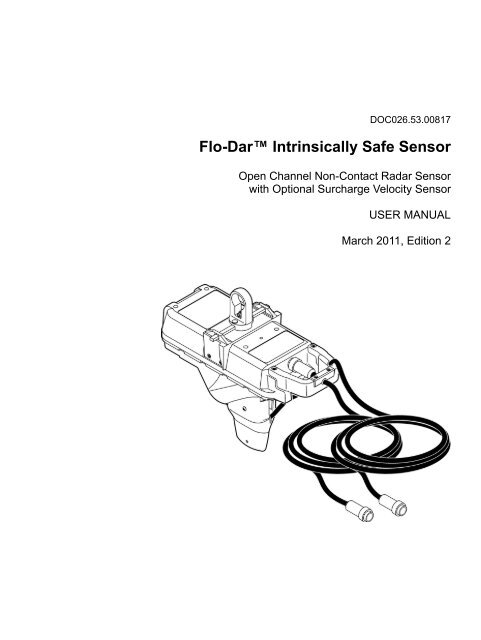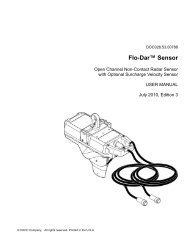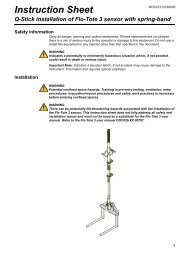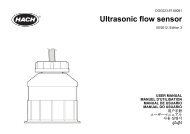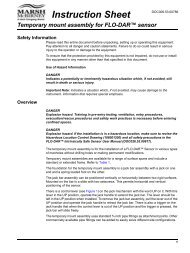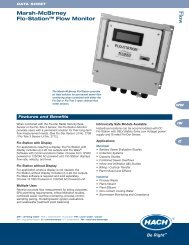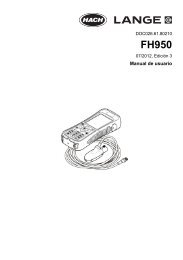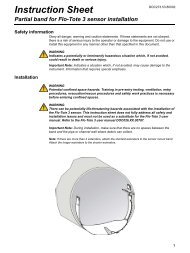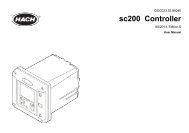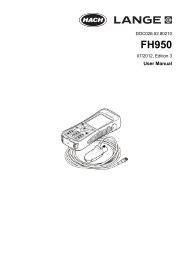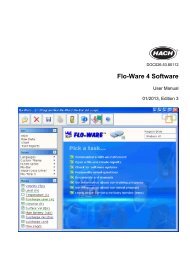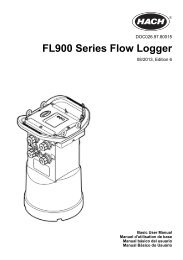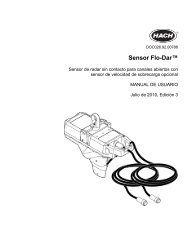Flo-Dar⢠Intrinsically Safe Sensor - Hachflow
Flo-Dar⢠Intrinsically Safe Sensor - Hachflow
Flo-Dar⢠Intrinsically Safe Sensor - Hachflow
Create successful ePaper yourself
Turn your PDF publications into a flip-book with our unique Google optimized e-Paper software.
DOC026.53.00817<strong>Flo</strong>-Dar <strong>Intrinsically</strong> <strong>Safe</strong> <strong>Sensor</strong>Open Channel Non-Contact Radar <strong>Sensor</strong>with Optional Surcharge Velocity <strong>Sensor</strong>USER MANUALMarch 2011, Edition 2
Table of contents2
Section 1SpecificationsSpecifications are subject to change without notice.GeneralcETLus Listed, ATEX EC-Type Certified<strong>Flo</strong>-Dar: II2G, Ex ib IIB T4 Gb, ITS10ATEX27065X, andClass I, Zone 1 AEx ib IIB T4 Gb and Class I, Zone 1 Ex ib IIB T4 GbCertificationBarrier: II(2)G, [Ex ib Gb] IIB, ITS10ATEX27042X, and Class I, Zone 1 [AExib Gb] IIB and Class I, Zone 1 [Ex ib Gb] IIBOperating temperatureStorage temperatureAltitudeSVS: II2G, Ex ib IIB T4 Gb, ITS10ATEX27043X, and Class I, Zone 1 AEx ibIIB T4 Gb and Class I, Zone 1 Ex ib IIB T4 Gb–10 to 50 °C (14 to 122 °F)–40 to 60 °C (–40 to 140 °F)4000 m (13,123 ft) maximum3
Specifications4
Section 2General information2.1 <strong>Safe</strong>ty information2.1.1 Use of hazard information2.1.2 Precautionary labelsPlease read this entire manual before unpacking, setting up, or operating this equipment.Pay attention to all danger and caution statements. Failure to do so could result in seriousinjury to the operator or damage to the equipment.To ensure that the protection provided by this equipment is not impaired, do not use orinstall this equipment in any manner other than that specified in this manual.DANGERIndicates a potentially or imminently hazardous situation which, if not avoided, willresult in death or serious injury.DANGERIndique une situation de danger potentiel ou imminent qui, si elle n'est pas évitée,peut entraîner la mort ou des blessures graves.WARNINGIndicates a potentially or imminently hazardous situation which, if not avoided,could result in death or serious injury.AVERTISSEMENTIndique une situation de danger potentiel ou imminent qui, si elle n'est pas évitée,pourrait entraîner la mort ou des blessures graves.CAUTIONIndicates a potentially hazardous situation that may result in minor or moderateinjury.ATTENTIONIndique une situation potentiellement dangereuse qui peut entraîner des blessuresmineures ou modérées.Important Note: Indicates a situation which, if not avoided, may cause damage to theinstrument. Information that requires special emphasis.Remarque importante: Indique une situation qui, si elle n'est pas évitée, peut provoquerdes dommages à l'appareil. Informations nécessitant une insistance particulière.Note: Information that supplements points in the main text.Remarque : Informations complétant des points du texte principal.Read all labels and tags attached to the instrument. Personal injury or damage to theinstrument could occur if not observed.This is the safety alert symbol. Obey all safety messages that follow this symbol to avoid potential injury. If on theinstrument, refer to the instruction manual for operation or safety information.Ceci est le symbole d'alerte de sécurité. Se conformer à tous les messages de sécurité qui suivent ce symbole afind'éviter des blessures potentielles. Si apposés sur l'instrument, se référer au manuel d'utilisation pour lefonctionnement ou les informations de sécurité.5
General informationElectrical equipment marked with this symbol may not be disposed of in European public disposal systems after12 August of 2005. In conformity with European local and national regulations (EU Directive 2002/96/EC),European electrical equipment users must now return old or end-of life equipment to the Producer for disposal at nocharge to the user.Note: For return for recycling, please contact the equipment producer or supplier for instructions on how to returnend-of-life equipment, producer-supplied electrical accessories, and all auxiliary items for proper disposal.L'équipement électrique marqué de ce symbole ne devra pas être détruit dans les systèmes dedestruction publics Européens après le 12 août 2005. En conformité avec les dispositions européenneslocales et nationales (Directive EU 2002/96/EC), les utilisateurs européens d'équipements électriquesdoivent maintenant renvoyer au fabricant pour destruction les équipements anciens ou en fin de vie,sans frais pour l'utilisateur.Remarque : Pour le retour à des fins de recyclage, veuillez contacter le fabricant ou le fournisseurd'équipement pour obtenir les instructions sur la façon de renvoyer l'équipement usagé, les accessoiresélectriques fournis par le fabricant, et tous les articles auxiliaires pour une mise au rebut appropriée.This symbol, when noted on a product enclosure or barrier, indicates that a risk of electrical shock and/orelectrocution exists.Si ce symbole ce trouve sur l’instrument, il indique la présence d’un danger de choc électrique ou d’électrocution.This symbol, when noted on the product, identifies the location of the connection for Protective Earth (ground).Ce symbole, lorsqu’il est apposé sur le produit, indique l’emplacement de la connexion de mise à la terre.This symbol, when noted on the product, identifies the location of a fuse or current limiting device.Lorsque ce symbole se trouve sur un produit, il indique l’emplacement d’un fusible ou autre protection contre lessurcharges.This symbol, when noted on the product, indicated the presence of devices sensitive to Electro-static Discharge(ESD) and indicated that care must be taken to prevent damage with the equipment.Ce symbole, s'il figure sur le produit, indiqué la présence des dispositifs sensibles à la décharge électrostatique(ESD) et la nécessité d'agir avec précaution pour éviter d'endommager l'équipement.2.1.3 Confined space precautionsDANGERExplosion hazard. Training in pre-entry testing, ventilation, entry procedures,evacuation/rescue procedures and safety work practices is necessary beforeentering confined spaces.DANGERDanger d'explosion. Une formation incluant des tests de pré-entrée, la ventilation,les procédures d'entrée, les procédures d'évacuation/de sauvetage et des pratiquesde travail de sécurité est nécessaire avant d'entrer dans des espaces restreint.Important Note: The following information is provided to guide users of <strong>Flo</strong>-Dar <strong>Sensor</strong>son the dangers and risks associated with entry into confined spaces.Remarque importante : Les informations suivantes sont fournies dans le but d'informerles utilisateurs des capteurs <strong>Flo</strong>-Dar des dangers et des risques associés à l'accès auxespaces confinés.On April 15, 1993, OSHA’s final ruling on CFR 1910.146, Permit Required ConfinedSpaces, became law. This new standard directly affects more than 250,000 industrialsites in the U.S.A., and was created to protect the health and safety of workers inconfined spaces.6
2.2 Product overviewGeneral informationDefinition of a confined space:A confined space is any location or enclosure that presents or has the immediatepotential to present one or more of the following conditions:• An atmosphere with less than 19.5% or greater than 23.5% oxygen and/or more than10 ppm Hydrogen Sulfide (H 2 S).• An atmosphere that may be flammable or explosive due to gases, vapors, mists, dustsor fibers.• Toxic materials which upon contact or inhalation, could result in injury, impairment ofhealth or death.Confined spaces are not designed for human occupancy. They have restricted entry andcontain known or potential hazards. Examples of confined spaces include manholes,stacks, pipes, vats, switch vaults, and other similar locations.Standard safety procedures must always be followed prior to entry into confined spacesand/or locations where hazardous gases, vapors, mists, dusts or fibers may be present.Before entering any confined space check with your employer for procedures related toconfined space entry.The <strong>Flo</strong>-Dar <strong>Intrinsically</strong> <strong>Safe</strong> <strong>Sensor</strong> measures the flow velocity and liquid depth in openchannels using radar and ultrasonic technology. The unit is designed to withstandsubmersion during surcharge conditions. The optional surcharge velocity sensor providesvelocity measurements during surcharge conditions.Figure 1 shows the configuration of a <strong>Flo</strong>-Dar system in a hazardous location installation.Figure 1 System overview1 Hazardous environment 4 Logger or controller2 Non-hazardous environment 5 Mounting frame3 <strong>Intrinsically</strong> safe barrier 6 <strong>Flo</strong>-Dar sensor with optional surcharge velocity sensor7
General information8
Section 3InstallationDANGERExplosion hazard. Trained personnel only must install or commission theequipment.DANGERDanger d'explosion. Seul le personnel formé est autorisé à installer ou à mettre enservice l'équipement.This chapter includes only the installation information for hazardous location use. For theinstallation, operation, and replacement part and accessory information fornon-hazardous location use, refer to the <strong>Flo</strong>-Dar <strong>Sensor</strong> User Manual.3.1 Precautions for hazardous location installationsDANGERExplosion hazard. To ensure safety, the installation of instruments in hazardouslocations must follow the specifications in the control drawings. Any modificationto the instrumentation or to the installation may result in life threatening injuryand/or damage to facilities.DANGERDanger d'explosion. Pour assurer la sécurité, l'installation des instruments dansdes emplacements dangereux doivent suivre les spécifications dans l'emplacementdangereux indiqué sur la fiche technique. Toute modification de l'appareil ou del'installation peut conduire à des préjudices constituant un danger de mort et/oudes dégâts sur les installations.The <strong>Flo</strong>-Dar <strong>Intrinsically</strong> <strong>Safe</strong> <strong>Sensor</strong> is listed as intrinsically safe for Class 1, Zone 1,Group IIB Hazardous Locations. This means that the circuits within these sensors cannotproduce a spark or thermal effect that could ignite a mixture of flammable or combustiblegases when installed properly. It does not mean that these sensors are explosion proof. Ifproper safety precautions are not followed, or if the equipment is not installed properly,there is a serious potential for explosion. Be sure to review all safety precautions,installation and wiring practices throughout this manual before installing the <strong>Flo</strong>-Dar<strong>Intrinsically</strong> <strong>Safe</strong> <strong>Sensor</strong>.3.1.1 <strong>Intrinsically</strong> safe installation requirementsInstallation of this equipment must satisfy local electrical code requirements using thehazardous location control drawings and is subject to final approval by the authorityhaving jurisdiction. Install all associated apparatus, such as the intrinsically-safe barrier,logger or controller in a non-hazardous location.3.1.2 Hazardous location control drawingsDANGERExplosion hazard. Never connect items to the sensor that are not specified on thecontrol drawings. Do not connect or disconnect any equipment unless power hasbeen switched off or the area is known to be non-hazardous.DANGERDanger d'explosion. Ne branchez jamais au transmetteur des éléments ne figurantpas sur la fiche technique. Ne branchez et ne débranchez aucun équipement sansavoir préalablement coupé l'alimentation et vous être assuré que l'environnementne présentait aucun danger.Follow the control drawings provided (section 3.4 on page 15) and all codes andregulations for connection to the sensor in the hazardous location.9
Installation3.2 <strong>Sensor</strong> installation3.2.1 Install the frame on the wall3.3 Electrical installation3.3.1 Wiring safety informationWARNINGExplosion hazard. Installation of equipment into hazardous locations must be doneso that no friction can be generated between the <strong>Flo</strong>w Meter and any surroundingsurfaces.AVERTISSEMENTRisque d'explosion. L'installation de l'équipement dans des zones dangereusesdoit être effectuée de sorte qu'aucun frottement ne soit provoqué entre ledébitmètre et toute surface environnante.Mount the <strong>Flo</strong>-Dar sensor above the open channel on the wall of the manhole. Forhazardous locations, a barrier must be installed outside of the hazardous area.To prevent damage to the enclosure, do not mount the <strong>Flo</strong>-Dar sensor in a location thatreceives direct sunlight.DANGERExplosion hazard. Review the safety information in section 2.1 on page 5 andsection 3.1 on page 9 before entering a confined space.DANGERDanger d'explosion. Revoyez les information concernant la sécurité danssection 2.1 on page 5 et section 3.1 on page 9 avant d'entrer dans une espacerestreint.CAUTIONAlways disconnect power to the instrument when making any electricalconnections.ATTENTIONDébranchez toujours l'alimentation de l'appareil avant toute connexion électrique.WARNINGExplosion hazard. Voltage connections to the barrier must be from 12 VDCpowered loggers. Power can be supplied from a battery or 12 VDC SELV sourcewhich has 3rd party NRTL certifications for Canada and the U.S.A., and the correctCE marking and Declaration of Conformity for Europe.AVERTISSEMENTRisque d'explosion. La connections électrique sur le système de barrière desécurité est seulement possible avec des appareils alimentés en 12VDC.L'alimentation peut venir d'une batterie ou d'une source 12VDC séparée ou trèsbasse tension sécurisée (SELV) qui possède la 3ème partie de certifications NRTLpour le CANADA et USA, et le marquage CE et déclaration de conformité pourl'Europe.10
3.3.2 Electrical installation in a hazardous location3.3.2.1 Install the barrierInstallationA barrier with appropriate entity parameters must be installed between the sensor and thelogger or controller for installation in hazardous locations. If the SVS option is used, anadditional barrier with appropriate entity parameters must also be installed between theSVS component and the logger or controller.A barrier must be installed when the <strong>Flo</strong>-Dar sensor is installed in a hazardous locationas defined in section 3.1 on page 9. A barrier limits the power parameters to the devicethat is located in the hazardous area. The barrier and the logger or controller must alwaysbe installed in a non-hazardous location.The barrier has a dielectric strength of 500 Vrms between the intrinsically safe outputsand the frame of the apparatus. Separation between the intrinsically safe outputs andconnections to non-intrinsically safe devices and separation between separateintrinsically safe output channels (power, RS485A and RS485B) should be maintained inaccordance with the installation instructions and markings since there is no galvanicisolation between these circuits.Procedure1. Install the barrier on a wall in a non-hazardous environment (Figure 2 on page 12).2. Follow the control drawings provided (section 3.4 on page 15) and all codes andregulations for connection to the sensor in the hazardous location.11
InstallationFigure 2 Barrier dimensions1 Desiccant 2 Connector for protective earth ground (PEG)12
3.3.2.2 Wiring to the barrierUse the supplied cables for electrical wiring to the barrier. Make sure to install aprotective earth ground to the barrier.InstallationProcedure1. Remove the four screws from the cover of the barrier. Remove the cover.2. Insert the cable from the <strong>Flo</strong>-Dar sensor through the strain relief fitting on the side ofthe barrier with the hazardous area connection label (Figure 3 on page 14). Tightenthe strain relief.3. If the <strong>Flo</strong>-Dar sensor has the optional SVS component, insert the cable from the SVSsensor through the strain relief fitting on the side of the second barrier with thehazardous area connection label (Figure 3 on page 14). Tighten the strain relief.4. Prepare each wire.5. Install the wires in terminals J3 and J4 as shown in Figure 3 on page 14. Pull lightlyafter each insertion to make sure the connections are tight.6. Install the air tube from the sensor cable into the fitting in the barrier enclosure asshown in Figure 3 on page 14.WARNINGExplosion hazard. The air tube must stay attached to the fitting to make sure thatdust does not go into the enclosure if the fitting is damaged.AVERTISSEMENTRisque d'explosion. Le tube d'air doit rester fixé au raccord afin de s'assurer que dela poussière ne pénètre pas dans le boîtier si le raccord est endommagé.7. Insert the cable from the logger or controller through the strain relief fitting on theother side of the barrier (Figure 3 on page 14). Tighten the strain relief.8. Prepare each wire.9. Install the wires in terminals J1 and J2 as shown in Figure 3 on page 14. Pull lightlyafter each insertion to make sure the connections are tight.10. Replace the cover on the barrier and install the screws.11. Connect a protective earth ground (PEG) to the ground stud on the barrier (Figure 2on page 12) where local code or authorities permit or require such a connection. Ifrequired, use a copper wire that is AWG 9 or larger.13
InstallationFigure 3 Barrier wiring1 Cable to logger or controller 2 Cable from <strong>Flo</strong>-Dar or SVS sensor14
3.3.2.3 Connection to the logger or controllerInstallationImportant Note: The length of the cable between the barrier and the logger or controllercannot be longer than 750 feet.Remarque importante : La longueur du câble entre la plaque et l'enregistreur ou letransmetteur ne doit pas dépasser les 229 mètres.Connect the cable from the barrier to the logger or the controller:• Logger—connect the cable from the barrier to the connector on the logger. Makesure that the barrier that is connected to the <strong>Flo</strong>-Dar sensor is connected to the<strong>Flo</strong>-Dar connector on the logger. Make sure that the barrier that is connected tothe optional SVS sensor is connected to the SVS connector on the logger.• Controller—connect the cable from the barrier to the controller. For wire terminalconnections to the controller, refer to the user manual for the controller. Make surethat the barrier that is connected to the <strong>Flo</strong>-Dar sensor is connected to the <strong>Flo</strong>-Darterminal in the controller. Make sure that the barrier that is connected to theoptional SVS sensor is connected to the SVS terminal in the controller.Figure 4 Typical intrinsically safe configuration1 <strong>Flo</strong>-Dar sensor 4 Barrier2 <strong>Intrinsically</strong>-safe environment 5 750 ft maximum cable length between barrier and loggeror controller3 Non-intrinsically-safe environment 6 Logger or controller3.4 Approved <strong>Flo</strong>-Dar installation drawingsDANGERAny installation or flow meter configuration that is not specifically detailed on thefollowing control drawings is not allowed. In all cases, the local authority havingjurisdiction shall have the final say.DANGERIl est interdit de procéder à toute installation ou configuration d'un débitmètre quin'est pas explicitement détaillée dans les schémas de contrôle de l'installationci-dessous. Dans tous les cas, c'est l'autorité locale responsable qui aura le derniermot.Figure 5 on page 16, Figure 6 on page 17 and Figure 7 on page 18 are approved controldrawings. These certified drawings explain the ONLY approved method of installing the<strong>Flo</strong>-Dar sensor. Additionally, these drawings list both part number, description, and theonly certified sensors, probes, and associated equipment to be used with this sensor. Anysubstitutions will automatically void the <strong>Intrinsically</strong> <strong>Safe</strong> certification of the flow meterand could result in fire or explosion.15
Installation Figure 5 Installation Control Drawing 116
Installation Figure 6 Installation Control Drawing 217
Installation Figure 7 Installation Control Drawing 318
Maintenance4.1 Cleaning the instrumentDANGERExplosion hazard. Never attempt to wipe or clean the <strong>Flo</strong>-Dar or SVS sensor whilein a hazardous location. Do not use abrasives or high-pressure hoses or washersto clean the sensors. Do not disturb the pressure port on the bottom of the sensor.DANGERDanger d'explosion. N'essayez jamais d'essuyer ou de nettoyer le <strong>Flo</strong>-Dar ou lecapteur SVS dans un emplacement dangereux. N'utilisez pas de produits abrasifsou de tuyaux sous pression ou d'appareils de nettoyage pour nettoyer les capteurs.Ne dérangez pas le port sous pression situé dans le bas du capteur.20
U.S. and countries other than EUHACH COMPANY4539 Metropolitan CourtFrederick, MD, 21704-9452, U.S.A.Tel. (800) 368-2723Fax (301) 874-8459hachflowsales@hach.comwww.hachflow.comMarsh-McBirney and Sigma <strong>Flo</strong>wProducts (except Sigma <strong>Flo</strong>wProducts in France and the UK)FLOWTRONIC, SA.Rue J.H. Cool 19aB-4840 Welkenraedt, BelgiumTel. +32 (0) 87 899 799Fax +32 (0) 87 899 790www.flow-tronic.comFrance and UK(Sigma <strong>Flo</strong>w Products Only)HACH LANGE GmbHWillstätterstraße 11D-40549 Düsseldorf, GermanyTel. +49 (0) 211 5288-0Fax +49 (0) 211 5288-143E-mail: info@hach-lange.dewww.hach-lange.com© Hach Company/Hach Lange GmbH, 2010, 2011. All rights reserved. Printed in U.S.A.


